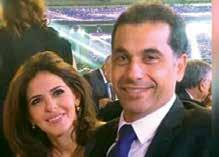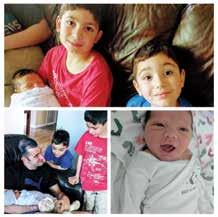
4 minute read
Bringing History Alive in the Classroom
Imagine a history teacher standing at the top of the class giving her power point presentation. Imagine students dutifully copying the words – one by one – silently groaning at the very mere idea of memorizing all these terms and dates in time for the upcoming test.
Sounds familiar?
This, unfortunately, is what most history classes look like across the country today.
Now imagine, a teacher engaging students in debates about a history topic. Imagine her or him questioning their ideas and thoughts. Imagine students linking historical events to current ones. Imagine students themselves challenging their peers and teachers to debates.
Just imagine history coming alive in the classroom.
This is the future of a history classroom and the aim of Nayla Hamadeh ’84 when she launched the Lebanese Association for History (LAH) six years ago.
“Our teaching methodology is all wrong,” she said. “A history class shouldn’t just be about terms and dates. The past has to be linked to the present or else why are we teaching history?”
Hamadeh herself was a history teacher, right here at IC, when she found herself becoming increasingly frustrated with the teaching methods – especially in the Lebanese program. And yes, while she did try to get her lessons to be more lively and interactive with the additions of texts, pictures, videos and historical maps and basically “nurtured thinking,” she said, it just wasn’t enough.
Still, she wasn’t quite sure how to ease her increasing frustrations until 2011, when IC sent her to attend a conference for educators. With a pleasant shock, she discovered that other attending Lebanese teachers from other schools and university professors, shared her frustrations. Would they be willing to form a team and spearhead efforts to change things?
In 2012, together, with university professors Bassel Akar, Maha Shuayb and school teachers Khalil Makar and Youssef About Antoun, they held their first meeting at a local café. Thus, the birth of the LAH.
In 2013, the LAH organized a conference to introduce a disciplinary approach to history pedagogy in Lebanon. History teachers across the country were invited to attend.
The response was overwhelming. But more overwhelming was the arrival of several former militiamen on the day of the conference.
“We would also like to discuss the civil war,” they said simply.
At first, Hamadeh was taken aback but soon the discussion ran so deep
that another day was added to the supposedly one-day conference.
“We were really listening to each other’s perspective,” she said.
The problem of teaching history in Lebanon is two-fold. One, the teaching of history is still painfully – well – primitive. And two, the Lebanese government has yet to concur about a common textbook on the country’s history.
Help came from three sources: Finland, Cyrus and the UK.
As luck would have it, a group of Finnish history teachers were taking a cultural tour of Lebanon and Syria in an effort to learn about their histories. Finland’s school system has consistently come at the top for the international rankings for education systems. They had especially devised an innovative way to teach their own 1918 civil war. Yes, they would be more than happy to share their innovative way of teaching history – especially about the civil war – with their Lebanese counterparts.
Soon after, the LAH team heard of an exceptional move in Cyprus: an association (AHDR - Association For Historical Dialogue and Research) located in the UN Buffer Zone separating the Greek and Turkish parts of the island, was bringing teachers from both sides and equipping them with the latest techniques in sensitive history teaching.
The AHDR soon arrived to Beirut to demonstrate activities they use with their own instructors to teach about the highly controversial Ottoman times.
Slowly but surely, Hamadeh was finding her way. “We were getting empowered,” she said. “We were gaining expertise on how to tackle the subject of history, civil war or other.”
Finally, the greatest breakthrough: the Historical Thinking Project – a UK created framework designed to foster a new approach to history education
It revolves around the idea that historical thinking — much like science or math — is central to teaching history and that students should become more competent as historical thinkers as they progress through their schooling. This ‘historical thinking’, revolves heavily on critical thinking skills and ‘historical literacy’.
At the end of the school years, historical literate students can assess and debate almost any historical subject. They will be able to see many sides of an event, its cause, and effect and decipher fact from opinion.
In 2014, LAH launched a one-year program to train middle and secondary school teacher in the Historical Thinking Approach. Their training took them across the country to Nabatieh, Tripoli and Chouf.
“At the beginning it was like teaching Chinese to the Lebanese, really,” said Hamadeh. “Teachers couldn’t understand. History is one narrative. You come and you teach. You want to make interactive ok you bring in documents. But what do you mean historical concepts?”
In 2016 and partnering with major universities, LAH launched a twoyear training program. The idea is that teachers become trainers in their own schools and LAH continues to “mentor” them.
“This is not just about curriculum and content, but more about livening up the teaching methodology for any subject in history,” said Hamadeh. “If you can’t bring history alive and link it to our reality, then we would be missing a lot.”











